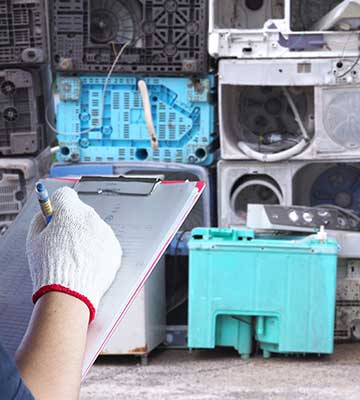
The Ultimate Guide to Commercial Junk Removal Services
August 27, 2025
How Junk Removal Can Benefit Your Office Relocation
August 27, 2025How to Safely Handle Appliance Removal in Your Business
Prioritize Employee Safety During Appliance Removal
When removing appliances from your business premises, the safety of your employees should be your top priority. Appliances can be heavy and cumbersome, posing significant risks if not handled correctly. Ensure that your team is trained in proper lifting techniques, such as bending at the knees and using the legs to lift, rather than the back. This approach helps prevent injuries like strains and sprains.
Additionally, provide your employees with appropriate personal protective equipment (PPE). This includes gloves to protect hands from sharp edges, sturdy footwear to prevent foot injuries, and safety glasses to shield eyes from debris. By equipping your team with the right tools and knowledge, you create a safer work environment and reduce the likelihood of accidents during appliance removal.
Disconnect Appliances Before Moving Them
Before attempting to move any appliance, it’s crucial to disconnect it from all power sources. This includes unplugging electrical cords, shutting off water supplies, and turning off gas lines. Failure to do so can lead to electrical shocks, water damage, or even fires. For appliances containing refrigerants, such as refrigerators and air conditioners, ensure that these substances are properly removed by a certified technician. This step is not only a safety measure but also a legal requirement in many areas.
Once disconnected, it’s advisable to drain any remaining fluids from the appliance. This reduces the risk of spills and makes the appliance lighter and easier to handle. By taking these precautions, you mitigate potential hazards and ensure a safer removal process for both your employees and your business premises.

Plan the Removal Route Carefully
Planning the path for appliance removal is essential to avoid accidents and property damage. Before moving the appliance, inspect the route for obstacles such as furniture, debris, or uneven flooring that could cause tripping hazards. Clear the path to create a safe and unobstructed route. If the appliance needs to be moved through narrow hallways or doorways, measure these spaces beforehand to ensure a proper fit.
Additionally, consider the flooring in the areas the appliance will pass through. Place protective coverings, like mats or cardboard, to prevent scratches or dents. If stairs are involved, use ramps or lifts designed for heavy loads to facilitate safe movement. By meticulously planning the removal route, you reduce the risk of accidents and damage, leading to a smoother and safer appliance removal process.
Utilize Proper Equipment for Heavy Appliances
Handling heavy appliances requires the right equipment to ensure safety and efficiency. Dollies, hand trucks, and appliance straps are invaluable tools that can make moving large items significantly easier. These tools help distribute the weight of the appliance, reducing the strain on individual workers and minimizing the risk of injury.
It’s important to select equipment that is appropriate for the specific appliance being moved. For instance, an appliance dolly with a strap can secure a refrigerator, preventing it from tipping over during transit. Regularly inspect this equipment for wear and tear, and replace any damaged tools promptly. By investing in quality equipment and maintaining it properly, you enhance the safety and efficiency of your appliance removal operations.
Dispose of Appliances Responsibly
Proper disposal of appliances is not only environmentally responsible but also often legally required. Many appliances contain hazardous materials, such as refrigerants, oils, or heavy metals, that can harm the environment if not disposed of correctly. Before disposal, ensure that all hazardous substances are removed by certified professionals. This may involve draining oils, removing refrigerants, or safely handling electronic components.
After ensuring the appliance is free of hazardous materials, explore recycling options. Many components of appliances, like metals and plastics, can be recycled, reducing the environmental impact. Work with certified recycling centers that specialize in appliance disposal to ensure compliance with local regulations. By taking these steps, you contribute to environmental conservation and adhere to legal requirements, demonstrating corporate responsibility.
Train Employees on Appliance Removal Procedures
Training your employees on the proper procedures for appliance removal is essential for maintaining a safe work environment. Provide comprehensive training that covers topics such as identifying hazardous materials, using equipment safely, and following legal disposal protocols. Regular refresher courses can help keep safety practices top of mind and address any new regulations or techniques.
Encourage employees to report any safety concerns or incidents during appliance removal. Establishing an open line of communication fosters a culture of safety and allows for continuous improvement of procedures. By investing in employee training and fostering a safety-conscious workplace, you reduce the likelihood of accidents and enhance the overall efficiency of your appliance removal operations.
Stay Informed About Local Regulations
Appliance removal and disposal are subject to various local, state, and federal regulations. These laws govern aspects such as refrigerant removal, recycling requirements, and hazardous waste handling. It’s crucial to stay informed about the specific regulations that apply to your business and ensure compliance to avoid legal penalties.
Regularly review local government websites or consult with environmental agencies to stay updated on any changes in regulations. Additionally, consider joining industry associations that provide resources and updates on compliance standards. By remaining proactive in understanding and adhering to regulations, you protect your business from legal issues and contribute to environmental sustainability.
Implement an Inventory Management System
An effective inventory management system can streamline the appliance removal process and improve overall efficiency. By keeping track of appliances that need to be removed, you can schedule pickups more effectively and ensure that all items are accounted for. This system can also help identify appliances that are still in good condition and may be suitable for donation or resale, reducing waste and benefiting the community.
Utilize software tools or spreadsheets to maintain an up-to-date inventory list. Include details such as the appliance type, location, condition, and any special handling instructions. Regularly audit your inventory to ensure accuracy and make adjustments as needed. By implementing a robust inventory management system, you enhance the organization and effectiveness of your appliance removal operations.
Coordinate with Professional Removal Services
While in-house removal can be effective, coordinating with professional appliance removal services can offer additional benefits. These services have specialized equipment and trained personnel to handle large or hazardous appliances safely and efficiently. They are also well-versed in local regulations and can ensure that all legal requirements are met during the removal and disposal process.
When selecting a professional removal service, consider factors such as their reputation, experience, and compliance with environmental standards. Request quotes and compare services to find the best fit for your business needs. By partnering with reputable professionals, you can enhance the safety and compliance of your appliance removal operations.
Maintain Documentation for Compliance and Reporting
Keeping thorough records of appliance removal activities is essential for compliance and reporting purposes. Document details such as the type and quantity of appliances removed, the methods of disposal, and any certifications for hazardous material handling. This documentation can be valuable for audits, insurance claims, or addressing any legal inquiries.
Implement a system for organizing and storing these records, whether digitally or in hard copy. Ensure that all relevant personnel have access to the necessary documentation and are trained in maintaining accurate records. By maintaining comprehensive documentation, you demonstrate due diligence and commitment to regulatory compliance in your appliance removal practices.
Conclusion
Handling appliance removal in your business requires careful planning, adherence to safety protocols, and compliance with regulations. By prioritizing employee safety, disconnecting appliances properly, planning removal routes, utilizing appropriate equipment, disposing of appliances responsibly, training employees, staying informed about regulations, implementing inventory management, coordinating with professional services, and maintaining documentation, you can ensure a safe and efficient appliance removal process.
For businesses in Santa Rosa, CA, seeking professional junk removal services, North Bay Junk Removal offers licensed, insured, and eco-friendly solutions. With a commitment to customer satisfaction, they handle everything from appliance removal to full property cleanouts. Contact them at 707-478-6817 to schedule a pickup or request a quote.




